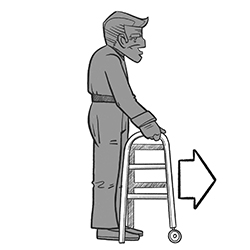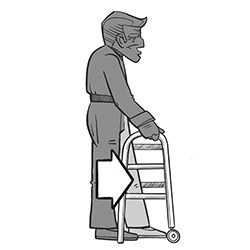Walking Aids
Walkers
When a person's mobility is impaired, their ability to participate in activities is often limited. As a result, it is not uncommon for these individuals to find themselves confined to their homes. Walking aids can help those in need regain some mobility by performing the following functions:
- Decrease or eliminate the weight on an injured, fragile or weak leg
- Compensate for a lack of balance
- Improve walking endurance
Regardless of the aid you choose, it should be properly fitted and you should employ the correct walking technique, as this will ensure safe, comfortable and effective use, while also reducing the risk of falls and injuries.
Selecting a walker
There are various types and models of walkers: some have wheels or braking systems, while others are foldable or come with accessories (integrated seat, basket, etc.).
Adjusting walker height
Setting the proper height is the same for all models of walkers. Simply follow the steps below:
- Stand tall and straight, and relax the shoulders.
- Place both heels in line with the back legs of the walker - your body should not be touching the front bar.
- Walker height should be at the crease of your wrists.
- Ensure the walker is level, and that all legs are at the same height.

Using a walker
To use a walker, follow the steps below:
- Place the walker one step length ahead of you (30 to 40 cm) with all four legs on the floor.
- Step forward with your weaker leg, so the foot is at the back of the walker.
- Use the walker for support and step forward with your stronger leg.
- Repeat the process.


Never use your walker on stairs or escalators.
[UNIPRIX] © Copyright Vigilance Santé
The patient information leaflets are provided by Vigilance Santé Inc. This content is for information purposes only and does not in any manner whatsoever replace the opinion or advice of your health care professional. Always consult a health care professional before making a decision about your medication or treatment.
